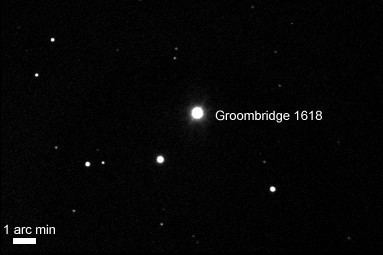Luminosity (bolometric) 0.15 L☉ Magnitude 6.6 | Luminosity (visual, LV) 0.046 L☉ Apparent magnitude (V) 6.6 | |
 | ||
Similar YZ Ceti, WISE 1506+7027, Groombridge 34, Kruger 60, Gliese 687 | ||
Groombridge 1618 is a star in the northern constellation Ursa Major. With an apparent visual magnitude of +6.6, it lies at or below the threshold of stars visible to the naked eye for an average observer. It is located close to Earth, at a distance of less than 16 light years. This is an main sequence star of spectral type K8 V, having just 67% of the Sun's mass. There is a suspected planetary companion with an orbital period of 122 days.
Contents
Properties
This star was first identified as entry number 1618 in the work A Catalog of Circumpolar Stars, published posthumously by Stephen Groombridge in 1838. It has a high proper motion across the sky, which is normally taken as an indicator that the star is located nearby—making it an early candidate for parallax measurement of its distance. In 1884 the parallax angle was measured as 0″.322 ± 0″.023, which is larger than the modern value of 0″.205.
Groombridge 1618 has a stellar classification of K8 V, which means it is a K-type main sequence star that is generating energy by fusing hydrogen at its core. It has 67% of the mass of the Sun, 61% of the Sun's radius, but radiates only 15% of the Sun's energy and only 4.6% of the Sun's energy in the visible light spectrum. The effective surface temperature of the star's photosphere is about 4,000 K, giving it an orange hue.
It is a BY Draconis variable with a surface magnetic field strength of 750 G. The chromosphere is relatively inactive and possesses star spots comparable to Sun spots. However, like the star UV Ceti, it has been observed to undergo increases in luminosity as a flare star. It has a greater luminosity than most flare stars, which are typically red dwarfs, but is less active. The level of activity suggests that this is a somewhat youthful star.
System
A search for an excess amount of infrared emission from this star by the Infrared Space Observatory came up negative, implying that Groombridge 1618 does not possess a debris disk (such as Vega). However, observations using the Herschel Space Observatory showed a small excess suggesting the presence of a low temperature debris disk. The data can be modeled by a ring of coarse, highly-reflective dust at a temperature below 22 K orbiting at least 51 AU from the host star. If this star does have a companion, astrometric measurements appear to place an upper bound of 3–12 times the mass of Jupiter on such a hypothetical object (for orbital periods in the range of 5–50 years).
According to Marcy & Benitz (1989), a possible periodicity of 122 days has been detected, inferring the potential presence of a massive planetary object with minimum mass 4 times that of Jupiter. This candidate planet has not been confirmed and the signal the authors had found could have been due to intrinsic stellar activity from the star's young age. If confirmed, the planet would be located within the star's habitable zone.
An examination of this system in 2010 using the MMT telescope fitted with adaptive optics failed to detect a planetary companion.
The habitable zone for this star, defined as the locations where liquid water could be present on an Earth-like planet, is at a radius of 0.26–0.56 AU, where 1 AU is the average distance from the Earth to the Sun.
